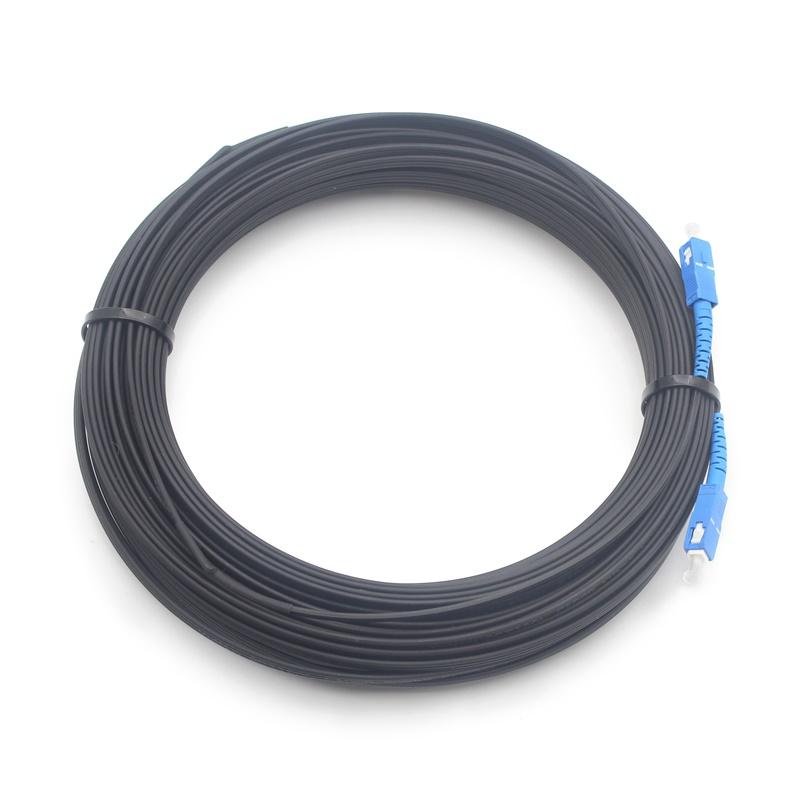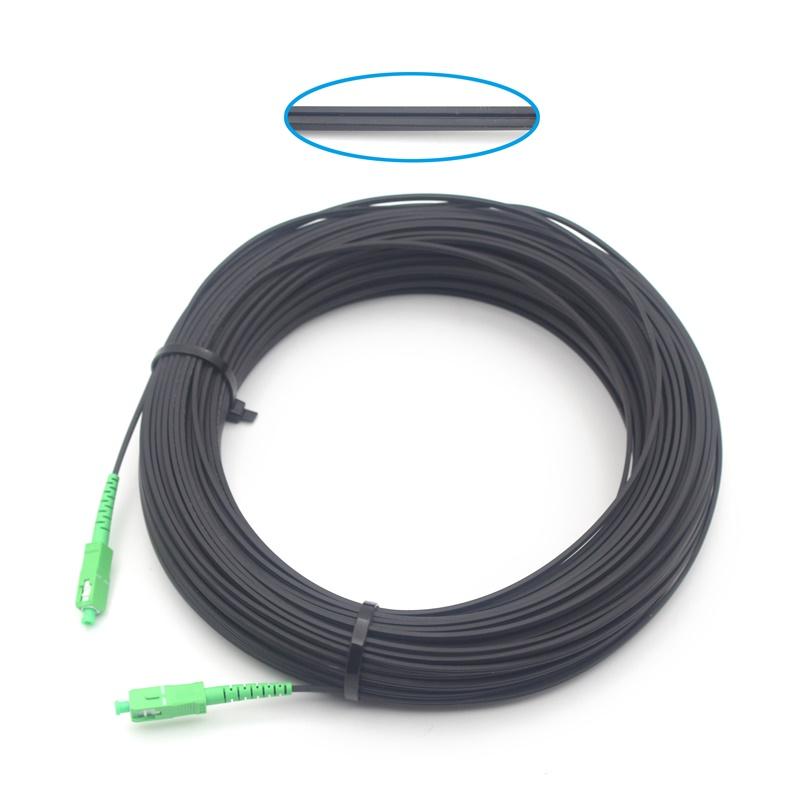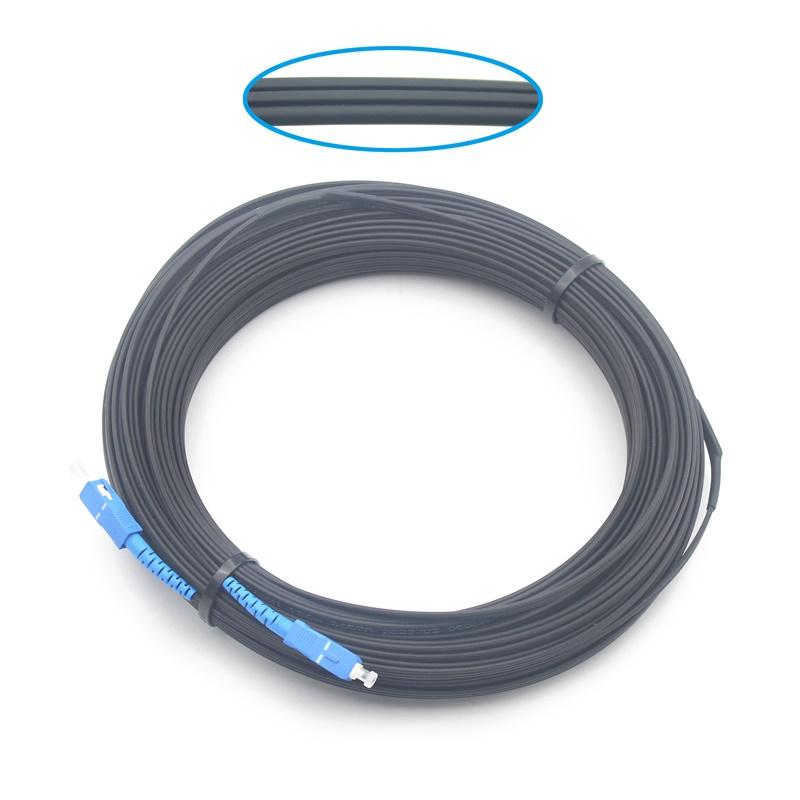
You must pay close attention when installing any FTTH Drop Cable Patch Cord to achieve a stable fiber optic link. Good handling helps prevent signal loss and long-term issues. For example, the 2.0×5.0mm SC APC Pre-connectorized FTTH Fiber Optic Drop Cable provides excellent performance if you follow proper steps. If you need a product for outdoor use, the Outdoor Black 2.0×5.0mm SC APC FTTH Drop Cable Patch Cord offers both durability and reliability. The 2.0×5.0mm SC UPC to SC UPC FTTH Drop Cable Patch Cord also supports high-quality connections in many environments.
Key Takeaways
- Always clean and inspect connectors before installation to prevent signal loss caused by dirt or damage.
- Handle cables gently, avoid sharp bends, and follow the minimum bend radius to protect the fiber inside.
- Align connectors carefully and double-check polarity to ensure strong and stable connections.
- Use quality cables and connectors that meet industry standards for better performance and durability.
- Plan your installation, organize cables neatly, and perform regular maintenance to keep your network reliable.
Common FTTH Drop Cable Patch Cord Installation Errors

Exceeding Loss Budget
You must pay attention to the loss budget when installing fiber optic cables. The loss budget is the total amount of signal loss that your system can handle before the connection fails. If you exceed this limit, your network may not work as expected. Each connector, splice, and length of cable adds a small amount of loss. You should always check the specifications for your FTTH Drop Cable Patch Cord and other components. Use a simple table to track your loss budget:
| Component | Typical Loss (dB) |
|---|---|
| Connector | 0.2 |
| Splice | 0.1 |
| 100m Cable | 0.4 |
Add up all the losses. Make sure the total stays below the maximum allowed for your system. If you go over, you may see weak signals or no connection at all.
Connector Contamination
Dirty connectors cause many fiber optic problems. Dust, oil, or fingerprints can block the light signal. You should always clean connectors before you connect them. Use a lint-free wipe or a special cleaning tool. Never touch the end face of the connector with your fingers. Even a small amount of dirt can cause big problems. Clean connectors help you get the best performance from your cable.
Tip: Always inspect connectors with a fiber scope before making a connection.
Misalignment of Connectors
You need to align connectors carefully. If the fiber cores do not line up, the signal cannot pass through easily. Misalignment can happen if you do not insert the connector straight or if you use too much force. Always follow the manufacturer’s instructions. Insert the connector gently until you hear or feel a click. This ensures a proper fit and good signal flow. Good alignment helps you avoid signal loss and keeps your network running smoothly.
Improper Polarity
You must pay close attention to polarity when installing fiber optic cables. Polarity means the direction that the light signal travels through the fibers. If you connect the cables with the wrong polarity, the signal will not reach the right place. This can cause your network to stop working. Always check the markings on the connectors before you plug them in. Many connectors have clear labels to help you match the correct ends. You can also use a simple chart to track polarity during installation.
Tip: Double-check the polarity before making the final connection. This step helps you avoid costly mistakes.
Overbending and Cable Damage
Fiber optic cables are strong, but they can break if you bend them too much. Overbending can cause the glass inside the cable to crack. This damage blocks the light signal and leads to poor performance. Each FTTH Drop Cable Patch Cord has a minimum bend radius. You should never bend the cable tighter than this limit. Use gentle curves when routing cables around corners or through tight spaces. If you see sharp bends, fix them right away.
- Do not pull or twist the cable.
- Avoid stepping on cables during installation.
- Use cable guides to keep bends smooth.
Poor Cable Management
Good cable management keeps your network safe and easy to maintain. If you leave cables tangled or loose, you risk damage and confusion. Poor cable management can also make it hard to find problems later. You should use cable ties, clips, or trays to organize your cables. Label each cable so you know where it goes. A neat setup saves time and prevents errors.
| Good Practice | Poor Practice |
|---|---|
| Use cable trays | Leave cables loose |
| Label each cable | No labels |
| Keep bends smooth | Sharp bends |
Keeping your cables organized helps you avoid future headaches and keeps your fiber optic system running smoothly.
Solutions for FTTH Drop Cable Patch Cord Installation

Proper Cleaning and Inspection
You should always start with clean connectors. Dust, oil, or even a fingerprint can block the light signal in a fiber optic cable. Use a lint-free wipe or a special fiber optic cleaning tool. Never touch the end face of the connector with your fingers. Before you connect anything, inspect the connector with a fiber scope. This tool helps you see if there is any dirt or damage.
Tip: Clean both ends of the patch cord before every installation. Even new cables can collect dust during shipping.
A simple cleaning routine helps you avoid signal loss and keeps your network running smoothly. If you see any dirt or scratches, clean the connector again or replace it if needed.
Correct Handling and Storage
Handle fiber optic cables with care. Do not bend, twist, or pull the cable too hard. Each cable has a minimum bend radius. If you bend the cable too much, you can break the glass inside. Always use gentle curves when routing cables.
Store your FTTH Drop Cable Patch Cord in a dry, dust-free place. Use cable reels or trays to keep cables organized. Avoid stacking heavy objects on top of cables. This prevents crushing and damage.
Here is a quick checklist for handling and storage:
- Hold cables by the connector housing, not the fiber.
- Avoid sharp bends or kinks.
- Store cables in a clean, dry area.
- Use cable ties or Velcro straps to keep cables neat.
Good storage and careful handling help your cables last longer and work better.
Using Quality Connectors and Cables
Choose high-quality connectors and cables for your fiber optic network. Quality parts give you lower signal loss and better performance. The 2.0×5.0mm SC UPC to SC UPC FTTH Drop Cable Patch Cord uses strong materials and precise connectors. This design helps you get a stable and reliable connection.
Look for cables that meet industry standards. Check for features like low insertion loss, high return loss, and flame-resistant materials. These features help your network stay safe and efficient.
| Feature | Why It Matters |
|---|---|
| Low insertion loss | Keeps signal strong |
| High return loss | Reduces signal reflection |
| Flame-resistant jacket | Improves safety |
| Durable connectors | Ensures long-term reliability |
Using quality connectors and cables saves you time and money by reducing the need for repairs.
Following Manufacturer Guidelines
You should always follow the manufacturer’s guidelines when installing fiber optic cables. These instructions help you avoid mistakes and keep your network working well. Each FTTH Drop Cable Patch Cord comes with specific recommendations for use. The guidelines tell you how to handle, connect, and test the cable. You can find important details about bend radius, insertion force, and cleaning methods in the product manual.
Tip: Read the manual before you start your installation. This step helps you understand the best way to use your cable.
Manufacturers test their products to meet industry standards. They know what works best for their cables. If you skip steps or ignore instructions, you risk damaging the cable or causing signal loss. Always use the tools and accessories suggested by the manufacturer. For example, use the right cleaning kit and connector type. This practice helps you get the best performance from your fiber optic system.
Here is a simple checklist to follow:
- Read the product manual.
- Use the recommended tools.
- Follow the cleaning steps.
- Check the minimum bend radius.
- Test the connection after installation.
You protect your investment and save time by following these steps. You also make sure your network stays reliable.
Ensuring Correct Polarity and Alignment
You need to pay close attention to polarity and alignment during installation. Polarity means the direction the light signal travels through the fiber. If you connect the cables with the wrong polarity, the signal will not reach the right device. This mistake can stop your network from working.
Alignment is just as important. The fiber cores must line up perfectly for the light to pass through. If the connectors are not aligned, you will see signal loss or poor performance. Always insert the connectors straight and gently. Listen for a click or feel for a snap to know the connection is secure.
Note: Double-check the markings on each connector before you make the final connection.
You can use a simple table to track polarity and alignment:
| Step | What to Check |
|---|---|
| Match connector ends | Check labels and color |
| Align connectors | Insert straight |
| Test signal | Use a light source |
If you follow these steps, you help your FTTH Drop Cable Patch Cord deliver strong and stable connections. Careful work at this stage prevents problems later.
Troubleshooting FTTH Drop Cable Patch Cord Issues
Visual Inspection Tools
You can spot many fiber optic problems with a simple visual inspection. Use a fiber inspection microscope or a fiber scope to look at the connector end face. These tools help you see dust, scratches, or cracks that block the light signal. Hold the connector steady and focus the scope on the tip. If you see any dirt or damage, do not connect the cable. Always check both ends before you make a connection.
Tip: A quick inspection can save you hours of troubleshooting later.
Cleaning Kits and Methods
You need to keep connectors clean for the best signal. Use a fiber optic cleaning kit, which usually includes lint-free wipes, cleaning sticks, and cleaning fluid. Start by wiping the connector gently with a dry wipe. If you see stubborn dirt, use a small amount of cleaning fluid. Never use your shirt or a tissue. These can leave fibers or oil behind. After cleaning, inspect the connector again to make sure it is spotless.
Here is a simple cleaning checklist:
- Use only approved fiber cleaning tools.
- Clean both ends of the cable.
- Inspect after cleaning.
Loss Testing Equipment
You can measure signal loss with special tools. An optical power meter and a light source help you check if the cable works well. Connect one end of the cable to the light source and the other to the power meter. The meter shows how much light passes through the cable. Compare the reading to the cable’s specifications. If the loss is too high, check for dirty connectors, sharp bends, or damage.
| Tool | What It Does |
|---|---|
| Optical Power Meter | Measures signal strength |
| Light Source | Sends light through cable |
| Visual Fault Locator | Finds breaks or bends |
Note: Regular testing helps you catch problems early and keep your network strong.
Cable Management Accessories
You can keep your fiber optic setup neat and safe by using the right cable management accessories. Good cable management helps you avoid tangles, sharp bends, and accidental damage. It also makes future maintenance much easier.
Start with cable trays. These trays hold your cables in place and guide them along walls or ceilings. You can use them in homes, offices, or data centers. Cable trays come in different sizes and shapes. Choose one that fits your space and the number of cables you need to organize.
Cable ties are another helpful tool. You can use them to bundle cables together. Velcro ties work well because you can remove and reuse them. Plastic zip ties are strong, but you need to cut them off if you want to make changes. Always avoid pulling ties too tight. Tight ties can crush the cable and hurt performance.
Tip: Use color-coded cable ties or labels to mark different cables. This makes it easy to find the right cable when you need to make changes.
Cable clips and hooks help you route cables along walls or under desks. You can stick or screw them into place. These accessories keep cables off the floor and out of the way. You lower the risk of someone tripping or stepping on the cables.
Here is a simple table showing common cable management accessories and their uses:
| Accessory | Use |
|---|---|
| Cable Tray | Holds and routes cables |
| Velcro Tie | Bundles cables, reusable |
| Zip Tie | Bundles cables, single-use |
| Cable Clip | Secures cables to surfaces |
| Cable Hook | Hangs cables neatly |
When you use these accessories, you protect your cables and keep your network running smoothly. You also make your workspace look more professional. If you use a product like the 2.0×5.0mm SC UPC to SC UPC FTTH Drop Cable Patch Cord, good cable management will help you get the best results.
Best Practices for Reliable FTTH Drop Cable Patch Cord Connections
Pre-Installation Planning
You should always start with a clear plan before you install any fiber optic cable. Good planning helps you avoid mistakes and saves time. First, check the layout of your building or site. Mark the places where you want to run the cables. Measure the distance between each point. This step helps you choose the right length for your FTTH Drop Cable Patch Cord. Make sure you have all the tools and accessories ready. You can use a checklist to keep track:
- Cable length and type
- Connectors and adapters
- Cleaning tools
- Cable management accessories
Tip: Walk through the installation path before you begin. This helps you spot any obstacles or tight spaces.
Documentation and Labeling
You need to keep good records during installation. Write down the cable routes and connection points. Label each cable at both ends. Use clear and simple labels. This practice helps you find cables quickly if you need to fix or upgrade your network later. You can use a table to organize your records:
| Cable ID | Location Start | Location End | Date Installed |
|---|---|---|---|
| 001 | Patch Panel A | Room 101 | 2024-06-01 |
| 002 | Patch Panel B | Room 102 | 2024-06-01 |
Good documentation makes troubleshooting much easier.
Regular Maintenance and Monitoring
You should check your cables and connections often. Look for signs of wear, dirt, or damage. Clean the connectors with the right tools. Test the signal strength with a power meter. If you find any problems, fix them right away. Regular checks help you keep your network running smoothly. You can set a schedule for maintenance, such as once every three months.
- Inspect connectors for dust or scratches
- Test signal loss with proper equipment
- Replace damaged cables quickly
Regular maintenance helps you avoid bigger problems in the future.
You can prevent most installation errors by following best practices for your FTTH Drop Cable Patch Cord. Careful planning, proper cleaning, and regular maintenance help you achieve reliable fiber optic connections. Pay attention to each step and use the right tools.
Remember: Consistent technique leads to fewer problems and better performance.
Take action today to ensure your FTTH installations stay error-free.
FAQ
What is the minimum bend radius for an FTTH drop cable patch cord?
You should check the product manual for the exact number. Most FTTH drop cable patch cords, like the 2.0×5.0mm SC UPC to SC UPC, need a gentle curve. Avoid sharp bends to protect the fiber inside.
How do you clean fiber optic connectors before installation?
Use a lint-free wipe or a special fiber cleaning tool. Never touch the connector tip with your fingers. Always inspect the connector after cleaning to make sure it is free of dust or oil.
Why does signal loss happen in fiber optic cables?
Signal loss can happen from dirty connectors, sharp bends, or poor alignment. You should always keep connectors clean and avoid bending the cable too much. Use proper installation steps to keep the signal strong.
Can you use the same patch cord for indoor and outdoor installations?
Many patch cords, like the 2.0×5.0mm SC UPC to SC UPC, work well both indoors and outdoors. Always check the product’s specifications for temperature and weather resistance before you install it outside.
Tip: Always store extra cables in a dry, dust-free place to keep them in good condition.
By: Consult
Tel: +86 574 27877377
Mb: +86 13857874858
E-mail: henry@cn-ftth.com
Youtube: DOWELL
Pinterest: DOWELL
Facebook: DOWELL
Linkedin: DOWELL
Post time: Aug-01-2025
